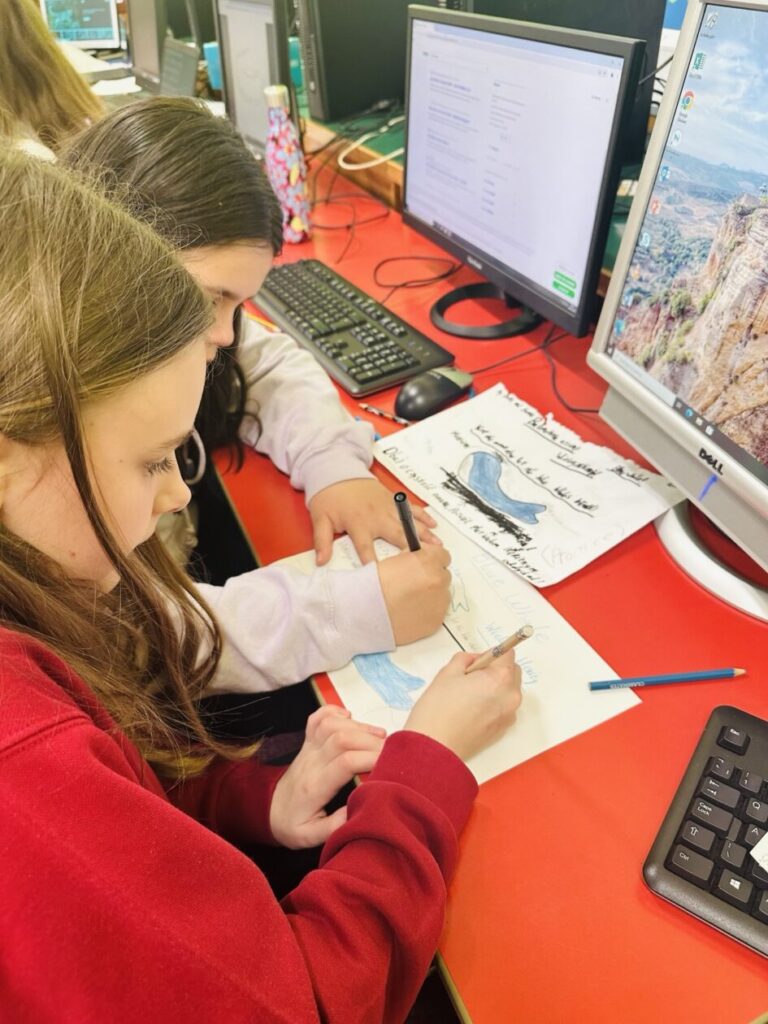🌍🎨 P5-7 Explore Languages & Art in Live Lesson with SCILT! 🎨🌍
Today, our Primary 5-7 pupils took part in an amazing live lesson with SCILT, Scotland’s National Centre for Languages! They teamed up with another school over Microsoft Teams to explore multilingualism and art, linking different languages with creative expression. 🎭✨
To tie this into World Earth Day, the pupils researched endangered species and found out their names in different languages. Then, during the live lesson, they worked together in pairs and groups to create eye-catching posters featuring their chosen animals and slogans translated into multiple languages. The goal? To raise awareness of endangered species in a way that speaks to people from all over the world! 🌏🐾
The range of languages used was incredible! Of course, we had English, but the pupils also chose Scots and Gaelic, representing languages spoken here in Scotland. They included Polish, Italian, and Filipino, as we have pupils with family roots in these countries, and used French and Spanish, which we learn in school. Some pupils even went further, adding German, Japanese and Chinese—just out of pure curiosity and interest!
The pupils absolutely loved the task and worked brilliantly together, showing fantastic teamwork and creativity. Many were keen to speak into the microphone and share their research with the SCILT presenters, confidently explaining their findings and even using the different languages! 🎤👏
The SCILT team were so impressed with our pupils’ engagement and enthusiasm that they’ve asked us to send all the posters to them—what an achievement! 🏆 Well done, everyone!
It’s fantastic to see our pupils engaging with language and culture while also enjoying the beauty of art. What a brilliant way to celebrate multilingualism and creativity! 🎨✨
UNCRC Rights:
- Article 12 – Respect for the views of the child: Pupils were given the opportunity to express their ideas and share their multilingual posters with an external audience.
- Article 13 – Freedom of expression: Pupils used multiple languages and artistic expression to communicate their messages about endangered species.
- Article 29 – Goals of education: The activity promoted cultural awareness, creativity, and collaboration, encouraging pupils to appreciate linguistic diversity.
- Article 30 – Children from minority or Indigenous groups: This lesson actively celebrated linguistic and cultural diversity, ensuring that pupils with Polish, Filipino, Italian, and other backgrounds could see their languages represented and valued.
🌍 Sustainable Development Goals:
- SDG 4 – Quality Education: This lesson developed global citizenship by connecting language learning with environmental awareness and intercultural understanding.
- SDG 10 – Reduced Inequalities: Pupils explored language diversity and the importance of minority languages, ensuring inclusive representation.
- SDG 13 – Climate Action: Pupils explored endangered species and environmental issues, linking language learning to real-world concerns.
- SDG 14 – Life Below Water: Pupils researched endangered marine species like blue whales and axolotls, learning about the importance of protecting aquatic ecosystems.
- SDG 15 – Life on Land: The project raised awareness about the importance of protecting endangered animals and their habitats.
🏥 SHANARRI Indicators:
- Respected – Pupils learned about different languages and cultures, ensuring that everyone’s background was valued.
- Included – The activity encouraged linguistic diversity and representation, fostering a sense of belonging for pupils with multilingual backgrounds.
- Achieving – Pupils developed language, research, and presentation skills, as well as artistic abilities.
🛠️ Meta-skills Used:
- Adapting – Pupils navigated different languages and adjusted their approach when translating phrases.
- Initiative – They explored languages beyond what they normally learn in school, showing curiosity.
- Communicating – Pupils confidently spoke into the microphone and explained their research.
- Feeling – They developed empathy for endangered species and an appreciation for cultural diversity.
- Curiosity – Pupils were keen to explore new languages and apply their learning in creative ways.
- Creativity – They designed visually engaging posters that combined language, slogans, and artistic expression.
📖 Strands of Faith:
- Image of God – Celebrating the uniqueness of languages and cultures, recognising that every person is valued and created in God’s image.
- Signs of God – Using art and multilingual expression as a way of sharing important messages about creation and care for the planet.
- Reign of God – Reinforcing the values of justice, inclusion, and respect for others, particularly in celebrating cultural diversity.






















